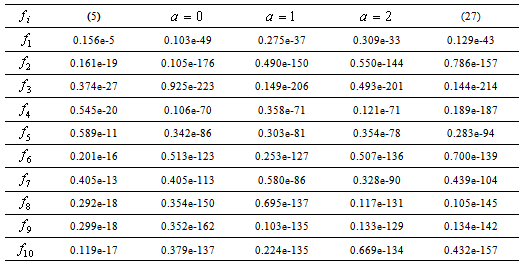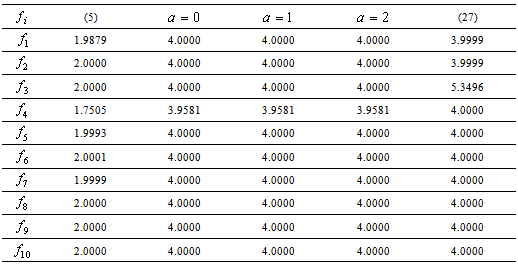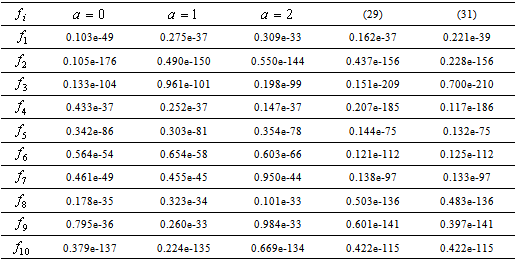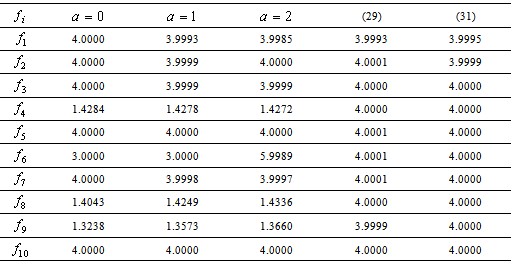R. Thukral
Padé Research Centre, 39 Deanswood Hill, Leeds, West Yorkshire, LS17 5JS, England
Correspondence to: R. Thukral, Padé Research Centre, 39 Deanswood Hill, Leeds, West Yorkshire, LS17 5JS, England.
| Email: |  |
Copyright © 2012 Scientific & Academic Publishing. All Rights Reserved.
Abstract
In this paper, two new fourth-order derivative-free methods for finding multiple zeros of nonlinear equations are presented. In terms of computational cost the family requires three evaluations of functions per iteration. It is proved that the each of the methods has a convergence of order four. In this way it is demonstrated that the proposed class of methods supports the Kung-Traub hypothesis (1974) on the upper bound  of the order of multipoint methods based on
of the order of multipoint methods based on  function evaluations. Numerical examples suggest that the new methods are competitive to other fourth-order methods for multiple roots.
function evaluations. Numerical examples suggest that the new methods are competitive to other fourth-order methods for multiple roots.
Keywords:
Modified Newton’s Method, Root-finding, Nonlinear Equations, Multiple Roots, Order of Convergence
Cite this paper: R. Thukral, New Families of Fourth-Order Derivative-Free Methods for Solving Nonlinear Equations with Multiple Roots, American Journal of Computational and Applied Mathematics , Vol. 3 No. 4, 2013, pp. 207-213. doi: 10.5923/j.ajcam.20130304.02.
1. Introduction
In recent years, some modifications of Newton’s method for multiple roots have been proposed. Therefore, finding the roots of nonlinear equations is very important in numerical analysis and has many applications in engineering and other applied sciences. In this paper, we consider derivative-free methods to find a multiple root  of multiplicity m, i.e.,
of multiplicity m, i.e., 
 and
and  of a nonlinear equation
of a nonlinear equation  | (1) |
where  is a scalar function on an open interval B and it is sufficiently smooth in a neighbourhood of
is a scalar function on an open interval B and it is sufficiently smooth in a neighbourhood of  In recent years, some modifications of the Newton method for multiple roots have been proposed and analysed[1-3,5-16,18]. However, there are not many derivative-free methods known to handle the case of multiple roots. Hence we present two fourth-order methods for finding multiple zeros of a nonlinear equation and only use three evaluations of the function per iteration. In fact, we have obtained the optimal order of convergence which supports the Kung and Traub conjecture[6]. Kung and Traub conjectured that the multipoint iteration methods, without memory based on n evaluations, could achieve optimal convergence order
In recent years, some modifications of the Newton method for multiple roots have been proposed and analysed[1-3,5-16,18]. However, there are not many derivative-free methods known to handle the case of multiple roots. Hence we present two fourth-order methods for finding multiple zeros of a nonlinear equation and only use three evaluations of the function per iteration. In fact, we have obtained the optimal order of convergence which supports the Kung and Traub conjecture[6]. Kung and Traub conjectured that the multipoint iteration methods, without memory based on n evaluations, could achieve optimal convergence order  In addition, the new fourth-order method has an equivalent efficiency index to the established fourth-order methods presented in[9,14,18]. Furthermore, the new method has a better efficiency index than the third-order methods given in[1-3,7,10-13]. In view of this fact, the new method is simpler when compared with the established methods. Consequently, we have found that the new derivative-free methods are efficient and robust. Contents of the paper are summarized as follows: Some basic definitions relevant to the present work are presented in the section 2. In section 3 we describe the fourth-order methods that are free from derivatives and prove the important fact that the methods obtained preserve their convergence order. In section 4 we shall briefly state the established methods in order to compare the effectiveness of the new methods. Finally, in section 5 we demonstrate the performance of each of the methods described. If the derivative of the function f is difficult to compute or is expensive to obtain, then a derivative-free method is required. In this study, the new derivative-free iterative methods are based on a classical Steffensen’s method[12,19], which actually replaces the derivative in the classical Newton’s method with suitable approximations based on finite difference,
In addition, the new fourth-order method has an equivalent efficiency index to the established fourth-order methods presented in[9,14,18]. Furthermore, the new method has a better efficiency index than the third-order methods given in[1-3,7,10-13]. In view of this fact, the new method is simpler when compared with the established methods. Consequently, we have found that the new derivative-free methods are efficient and robust. Contents of the paper are summarized as follows: Some basic definitions relevant to the present work are presented in the section 2. In section 3 we describe the fourth-order methods that are free from derivatives and prove the important fact that the methods obtained preserve their convergence order. In section 4 we shall briefly state the established methods in order to compare the effectiveness of the new methods. Finally, in section 5 we demonstrate the performance of each of the methods described. If the derivative of the function f is difficult to compute or is expensive to obtain, then a derivative-free method is required. In this study, the new derivative-free iterative methods are based on a classical Steffensen’s method[12,19], which actually replaces the derivative in the classical Newton’s method with suitable approximations based on finite difference, | (2) |
 | (3) |
Therefore, the modified Newton’s method  | (4) |
becomes the modified Steffensen’s method | (5) |
In fact, it is well known that the modified Newton’s method (4) and the modified Steffensen’s method (5) have a convergence order of two[12,19].
2. Basic Definitions
In order to establish the order of convergence of the new derivative-free methods, we state some of the definitions:Definition 1 Let  be a real function with a simple root
be a real function with a simple root  and let
and let  be a sequence of real numbers that converges towards
be a sequence of real numbers that converges towards  The order of convergence p is given by
The order of convergence p is given by | (6) |
where  is the asymptotic error constant and
is the asymptotic error constant and  Definition 2 Let
Definition 2 Let  be the error in the kth iteration, then the relation
be the error in the kth iteration, then the relation | (7) |
is the error equation. If the error equation exists then p is the order of convergence of the iterative method.Definition 3 Let r be the number of function evaluations of the new method. The efficiency of the new method is measured by the concept of efficiency index[4] and defined as | (8) |
where p is the order of the method.Definition 4 Suppose that  and
and  are three successive iterations closer to the root
are three successive iterations closer to the root  of (1). Then the computational order of convergence[17] may be approximated by
of (1). Then the computational order of convergence[17] may be approximated by  | (9) |
3. Development of the Methods and Analysis of Convergence
In this section we define two new fourth-order derivative-free methods. In fact, the new methods are based on the second-order Steffensen’s method and are improved by introducing a weight-function in the second step of the iteration.
3.1. The Method M1
The first new fourth-order derivative-free method for finding multiple root of a nonlinear equation is based on the recently introduced method given in[15] and is expressed as | (10) |
 | (11) |
 | (12) |
where 

 ,
, 
 is the initial point and provided that the denominator of (11) and (12) are not equal to zero. In order to examine the convergence property of the new method (12), we prove the following theorem. Theorem 1 Let
is the initial point and provided that the denominator of (11) and (12) are not equal to zero. In order to examine the convergence property of the new method (12), we prove the following theorem. Theorem 1 Let  be a multiple root of multiplicity m of a sufficiently differentiable function
be a multiple root of multiplicity m of a sufficiently differentiable function  for an open interval B. If the initial point
for an open interval B. If the initial point  is sufficiently close to
is sufficiently close to  then the convergence order of iterative method defined by (7) is four.Proof Let
then the convergence order of iterative method defined by (7) is four.Proof Let  be a multiple root of multiplicity m of a sufficiently smooth function
be a multiple root of multiplicity m of a sufficiently smooth function  ,
, 
 and
and  .Using the Taylor expansion of
.Using the Taylor expansion of  and
and  about
about  , we have
, we have | (13) |
 | (14) |
where  and
and  | (15) |
Moreover by (11), we have | (16) |
The expansion of  about
about  is given as
is given as | (17) |
Simplifying (17), we get | (18) |
Furthermore, we have  | (19) |
Since from (12) we have | (20) |
Substituting appropriate expressions in (20) and after simplification we obtain the error equation | (21) |
The error equation (21) establishes the fourth-order convergence of the new derivative-free method defined by (12).
3.2. The Method M2
In this sub-section we define another fourth-order derivative-free method based on[14]. In this case we use a concept recently introduced in[14] and apply the derivative-free element in the second step. The new fourth-order method for finding multiple roots of a nonlinear equation is expressed as | (22) |
 | (23) |
 | (24) |
where 
 ,
, 
 is the initial point and provided that the denominator of (23) and (24) are not equal to zero.Theorem 2Let
is the initial point and provided that the denominator of (23) and (24) are not equal to zero.Theorem 2Let  be a multiple root of multiplicity m of a sufficiently differentiable function
be a multiple root of multiplicity m of a sufficiently differentiable function  for an open interval B. If the initial point
for an open interval B. If the initial point  is sufficiently close to
is sufficiently close to  , then the convergence order of iterative method defined by (24) is four.ProofSubstituting appropriate expressions in (24) and after simplification we obtain the error equation
, then the convergence order of iterative method defined by (24) is four.ProofSubstituting appropriate expressions in (24) and after simplification we obtain the error equation | (25) |
The error equation (25) establishes the fourth-order convergence of the new method defined by (24).
4. The Established Methods
For the purpose of comparison, we consider three fourth-order methods presented recently in[9,11,18]. Since these methods are well established, we state the essential expressions used in order to calculate the approximate solution of the given nonlinear equations and thus compare the effectiveness of the new fourth-order method for multiple roots.
4.1. The Wu el at. Method
In[18], Wu et al. developed a fourth-order method for finding multiple roots of nonlinear equations, since this method is well-established we state the essential expressions used in the method, | (26) |
 | (27) |
provided that the denominator of (26) and (27) are not equal to zero.
4.2. The Sharma et al. Method
In[9], Sharma et al. developed a fourth-order of convergence method, as before we state the essential expressions used in the method, | (28) |
 | (29) |
where 
 ,
, is the initial value and provided that the denominators of (28) and (29) are not equal to zero.
is the initial value and provided that the denominators of (28) and (29) are not equal to zero.
4.3. The Shengguo et al. Method
In[11], Shengguo et al. developed a fourth-order of convergence method, the particular expressions of the method is given as, | (30) |
 | (31) |
where


 ,
,  is the initial point and provided that the denominators of (30) and (31) are not equal to zero.
is the initial point and provided that the denominators of (30) and (31) are not equal to zero.
5. Application of the New Fourth-order Derivative-free Iterative Methods
The present fourth-order derivative-free methods are given by (12) and (24) are employed to solve nonlinear equations and compare with the modified Steffensen’s method, the Wu et al., the Sharma et al. and the Shengguo et al. methods (5), (27), (29) and (31), respectively. To demonstrate the performance of the new fourth-order methods, we use ten particular nonlinear equations. We shall determine the consistency and stability of results by examining the convergence of the new iterative methods. The findings are generalised by illustrating the effectiveness of the fourth-order derivative-free methods for determining the multiple roots of a nonlinear equation. Consequently, we give estimates of the approximate solutions produced by the fourth-order derivative-free methods and list the errors obtained by each of the methods. The numerical computations listed in the tables were performed on an algebraic system called Maple. In fact, the errors displayed are of absolute value and insignificant approximations by the various methods have been omitted in the following tables.Table 1. Test functions and their roots
 |
| |
|
The new fourth-order derivative-free method requires three function evaluations and has the order of convergence four. To determine the efficiency index of the new method, we shall use the definition 3. Hence, the efficiency index of the fourth-order method given is  which is identical to other established methods, given in section 4. The test functions and their exact root
which is identical to other established methods, given in section 4. The test functions and their exact root  are displayed in table 1. The difference between the root
are displayed in table 1. The difference between the root  and the approximation
and the approximation  , for test functions with initial point
, for test functions with initial point , are displayed in Table 2 and 4. In fact,
, are displayed in Table 2 and 4. In fact,  is calculated by using the same total number of function evaluations (TNFE) for all methods. In the calculations, 12 TNFE are used by each method. Furthermore, the computational order of convergence (COC) is displayed in Table 3 and 5.
is calculated by using the same total number of function evaluations (TNFE) for all methods. In the calculations, 12 TNFE are used by each method. Furthermore, the computational order of convergence (COC) is displayed in Table 3 and 5.Table 2. Comparison of new iterative methods (12)
 |
| |
|
Table 3. COC of various iterative methods (12)
 |
| |
|
Table 4. Comparison of new iterative methods (24)
 |
| |
|
Table 5. COC of various iterative methods (24)
 |
| |
|
6. Remarks and Conclusions
In this paper, we have introduced two new families of fourth-order derivative-free methods for solving nonlinear equations with multiple roots. Convergence analysis proves that the new derivative-free methods preserve the order of convergence. By simply introducing new parameters in the new methods we have achieved fourth-order convergence. The prime motive for presenting these new derivative-free methods was to establish a different approach to obtain fourth-order convergence method. We have examined the effectiveness of the new derivative-free methods by showing the accuracy of the multiple roots of several nonlinear equations. After an extensive experimentation, it can be concluded that the convergence of the tested multipoint methods of the fourth-order is remarkably fast. Furthermore, in most of the test examples, empirically we have found that the best results of the new methods are obtained when  , and the new method given by (12) is producing better approximation than the other similar methods. There are two major advantages of these new derivative-free methods. Firstly, we do not have to evaluate the derivative of the functions; therefore they are especially efficient where the computational cost of the derivative is expensive, and secondly we have established a new higher order of convergence method which is simple to construct. We have examined the effectiveness of the new derivative-free methods by showing the accuracy of the multiple root of a nonlinear equation. The main purpose of demonstrating the new higher order derivative-free methods for many different types of nonlinear equations was purely to illustrate the accuracy of the approximate solution, the stability of the convergence, the consistency of the results and to determine the efficiency of the new derivative-free methods. Finally, we conjecture that these new methods can be improved to obtain higher order methods.
, and the new method given by (12) is producing better approximation than the other similar methods. There are two major advantages of these new derivative-free methods. Firstly, we do not have to evaluate the derivative of the functions; therefore they are especially efficient where the computational cost of the derivative is expensive, and secondly we have established a new higher order of convergence method which is simple to construct. We have examined the effectiveness of the new derivative-free methods by showing the accuracy of the multiple root of a nonlinear equation. The main purpose of demonstrating the new higher order derivative-free methods for many different types of nonlinear equations was purely to illustrate the accuracy of the approximate solution, the stability of the convergence, the consistency of the results and to determine the efficiency of the new derivative-free methods. Finally, we conjecture that these new methods can be improved to obtain higher order methods.
ACKNOWLEDGEMENTS
I am grateful to the reviewer for his helpful comments on this paper.
References
| [1] | C. Chun, B. Neta, A third-order modification of Newton’s method for multiple roots, Appl. Math. Comput. 211 (2009) 474-479. |
| [2] | B. Ghanbari, B. Rahimi, M. G. Porshokouhi, A new class of third-order methods for multiple zeros, Int. J. Pure Appl. Sci. Tech. 3(2011) 65-71. |
| [3] | G. Fernandez-Torres, J. Vasquez-Aquino, Three new optimal fourth-order iterative methods to solve nonlinear equations, Adv. Numer. Anal.2013, doi.10.1155/2013/957496. |
| [4] | W. Gautschi, Numerical Analysis: an Introduction, Birkhauser, 1997. |
| [5] | S. Kumar, V. Kanwar, S. Singh, On some modified families of multipoint iterative methods for multiple roots of solving nonlinear equations, Appl. Math. Comput. 218 (2012) 7382-7394. |
| [6] | H. Kung, J. F. Traub, Optimal order of one-point and multipoint iteration, J. Assoc. Comput. Math. 21 (1974) 643-651. |
| [7] | N. Osada, An optimal multiple root-finding method of order three, J. Comput. Appl. Math. 51 (1994) 131-133. |
| [8] | E. Schroder, Uber unendich viele Algorithmen zur Auflosung der Gleichungen, Math. Ann. 2 (1870) 317-365. |
| [9] | J. R. Sharma, R. Sharma, Modified Jarratt method for computing multiple roots, Appl. Math. Comput. 217 (2010) 878-881. |
| [10] | J. R. Sharma, R. Sharma, Modified Chebyshev-Halley type method and its variants for computing multiple roots, Numer. Algor. 61 (2012) 567-578. |
| [11] | L. Shengguo, L. Xiangke, C. Lizhi, A new fourth-order iterative method for finding multiple roots of nonlinear equations, Appl. Math. Comput. 215 (2009) 1288-1292. |
| [12] | J. F. Steffensen, Remark on iteration, Skand. Aktuar Tidsr. 16 (1933) 64-72. |
| [13] | R. Thukral, A new third-order iterative method for solving nonlinear equations with multiple roots, J. Math. Comput. 6 (2010) 61-68. |
| [14] | R. Thukral, Introduction to higher order iterative methods for finding multiple roots of solving nonlinear equations, J. Math. Vol. 2013, doi: 10.1155/2013/404635 . |
| [15] | R. Thukral, A new family of fourth-order iterative methods for solving nonlinear equations with multiple roots, submitted to J. Numer. Math. Stoch. 2013. |
| [16] | J. F. Traub, Iterative Methods for solution of equations, Chelsea publishing company, New York 1977. |
| [17] | S. Weerakoon, T. G. I. Fernando, A variant of Newton’s method with accelerated third-order convergence, Appl. Math. Lett. 13 (2000) 87-93. |
| [18] | Z. Wu, X. Li, A fourth-order modification of Newtons method for multiple roots, IJRRAS 10 (2012) 166-170. |
| [19] | Q. Zheng, P. Zhao, L. Zhang, W. Ma, Variants of Steffensen-secant method and applications, Appl. Math. Com[put. 216 (2010) 3486-3496. |

 of the order of multipoint methods based on
of the order of multipoint methods based on  function evaluations. Numerical examples suggest that the new methods are competitive to other fourth-order methods for multiple roots.
function evaluations. Numerical examples suggest that the new methods are competitive to other fourth-order methods for multiple roots.
 of multiplicity m, i.e.,
of multiplicity m, i.e., 
 and
and  of a nonlinear equation
of a nonlinear equation 
 is a scalar function on an open interval B and it is sufficiently smooth in a neighbourhood of
is a scalar function on an open interval B and it is sufficiently smooth in a neighbourhood of  In recent years, some modifications of the Newton method for multiple roots have been proposed and analysed[1-3,5-16,18]. However, there are not many derivative-free methods known to handle the case of multiple roots. Hence we present two fourth-order methods for finding multiple zeros of a nonlinear equation and only use three evaluations of the function per iteration. In fact, we have obtained the optimal order of convergence which supports the Kung and Traub conjecture[6]. Kung and Traub conjectured that the multipoint iteration methods, without memory based on n evaluations, could achieve optimal convergence order
In recent years, some modifications of the Newton method for multiple roots have been proposed and analysed[1-3,5-16,18]. However, there are not many derivative-free methods known to handle the case of multiple roots. Hence we present two fourth-order methods for finding multiple zeros of a nonlinear equation and only use three evaluations of the function per iteration. In fact, we have obtained the optimal order of convergence which supports the Kung and Traub conjecture[6]. Kung and Traub conjectured that the multipoint iteration methods, without memory based on n evaluations, could achieve optimal convergence order  In addition, the new fourth-order method has an equivalent efficiency index to the established fourth-order methods presented in[9,14,18]. Furthermore, the new method has a better efficiency index than the third-order methods given in[1-3,7,10-13]. In view of this fact, the new method is simpler when compared with the established methods. Consequently, we have found that the new derivative-free methods are efficient and robust. Contents of the paper are summarized as follows: Some basic definitions relevant to the present work are presented in the section 2. In section 3 we describe the fourth-order methods that are free from derivatives and prove the important fact that the methods obtained preserve their convergence order. In section 4 we shall briefly state the established methods in order to compare the effectiveness of the new methods. Finally, in section 5 we demonstrate the performance of each of the methods described. If the derivative of the function f is difficult to compute or is expensive to obtain, then a derivative-free method is required. In this study, the new derivative-free iterative methods are based on a classical Steffensen’s method[12,19], which actually replaces the derivative in the classical Newton’s method with suitable approximations based on finite difference,
In addition, the new fourth-order method has an equivalent efficiency index to the established fourth-order methods presented in[9,14,18]. Furthermore, the new method has a better efficiency index than the third-order methods given in[1-3,7,10-13]. In view of this fact, the new method is simpler when compared with the established methods. Consequently, we have found that the new derivative-free methods are efficient and robust. Contents of the paper are summarized as follows: Some basic definitions relevant to the present work are presented in the section 2. In section 3 we describe the fourth-order methods that are free from derivatives and prove the important fact that the methods obtained preserve their convergence order. In section 4 we shall briefly state the established methods in order to compare the effectiveness of the new methods. Finally, in section 5 we demonstrate the performance of each of the methods described. If the derivative of the function f is difficult to compute or is expensive to obtain, then a derivative-free method is required. In this study, the new derivative-free iterative methods are based on a classical Steffensen’s method[12,19], which actually replaces the derivative in the classical Newton’s method with suitable approximations based on finite difference,



 be a real function with a simple root
be a real function with a simple root  and let
and let  be a sequence of real numbers that converges towards
be a sequence of real numbers that converges towards  The order of convergence p is given by
The order of convergence p is given by
 is the asymptotic error constant and
is the asymptotic error constant and  Definition 2 Let
Definition 2 Let  be the error in the kth iteration, then the relation
be the error in the kth iteration, then the relation

 and
and  are three successive iterations closer to the root
are three successive iterations closer to the root  of (1). Then the computational order of convergence[17] may be approximated by
of (1). Then the computational order of convergence[17] may be approximated by 





 ,
, 
 is the initial point and provided that the denominator of (11) and (12) are not equal to zero. In order to examine the convergence property of the new method (12), we prove the following theorem. Theorem 1 Let
is the initial point and provided that the denominator of (11) and (12) are not equal to zero. In order to examine the convergence property of the new method (12), we prove the following theorem. Theorem 1 Let  be a multiple root of multiplicity m of a sufficiently differentiable function
be a multiple root of multiplicity m of a sufficiently differentiable function  for an open interval B. If the initial point
for an open interval B. If the initial point  is sufficiently close to
is sufficiently close to  then the convergence order of iterative method defined by (7) is four.Proof Let
then the convergence order of iterative method defined by (7) is four.Proof Let  be a multiple root of multiplicity m of a sufficiently smooth function
be a multiple root of multiplicity m of a sufficiently smooth function  ,
, 
 and
and  .Using the Taylor expansion of
.Using the Taylor expansion of  and
and  about
about  , we have
, we have

 and
and 

 about
about  is given as
is given as








 ,
, 
 is the initial point and provided that the denominator of (23) and (24) are not equal to zero.Theorem 2Let
is the initial point and provided that the denominator of (23) and (24) are not equal to zero.Theorem 2Let  be a multiple root of multiplicity m of a sufficiently differentiable function
be a multiple root of multiplicity m of a sufficiently differentiable function  for an open interval B. If the initial point
for an open interval B. If the initial point  is sufficiently close to
is sufficiently close to  , then the convergence order of iterative method defined by (24) is four.ProofSubstituting appropriate expressions in (24) and after simplification we obtain the error equation
, then the convergence order of iterative method defined by (24) is four.ProofSubstituting appropriate expressions in (24) and after simplification we obtain the error equation





 ,
, is the initial value and provided that the denominators of (28) and (29) are not equal to zero.
is the initial value and provided that the denominators of (28) and (29) are not equal to zero. 




 ,
,  is the initial point and provided that the denominators of (30) and (31) are not equal to zero.
is the initial point and provided that the denominators of (30) and (31) are not equal to zero. which is identical to other established methods, given in section 4. The test functions and their exact root
which is identical to other established methods, given in section 4. The test functions and their exact root  are displayed in table 1. The difference between the root
are displayed in table 1. The difference between the root  and the approximation
and the approximation  , for test functions with initial point
, for test functions with initial point , are displayed in Table 2 and 4. In fact,
, are displayed in Table 2 and 4. In fact,  is calculated by using the same total number of function evaluations (TNFE) for all methods. In the calculations, 12 TNFE are used by each method. Furthermore, the computational order of convergence (COC) is displayed in Table 3 and 5.
is calculated by using the same total number of function evaluations (TNFE) for all methods. In the calculations, 12 TNFE are used by each method. Furthermore, the computational order of convergence (COC) is displayed in Table 3 and 5. , and the new method given by (12) is producing better approximation than the other similar methods. There are two major advantages of these new derivative-free methods. Firstly, we do not have to evaluate the derivative of the functions; therefore they are especially efficient where the computational cost of the derivative is expensive, and secondly we have established a new higher order of convergence method which is simple to construct. We have examined the effectiveness of the new derivative-free methods by showing the accuracy of the multiple root of a nonlinear equation. The main purpose of demonstrating the new higher order derivative-free methods for many different types of nonlinear equations was purely to illustrate the accuracy of the approximate solution, the stability of the convergence, the consistency of the results and to determine the efficiency of the new derivative-free methods. Finally, we conjecture that these new methods can be improved to obtain higher order methods.
, and the new method given by (12) is producing better approximation than the other similar methods. There are two major advantages of these new derivative-free methods. Firstly, we do not have to evaluate the derivative of the functions; therefore they are especially efficient where the computational cost of the derivative is expensive, and secondly we have established a new higher order of convergence method which is simple to construct. We have examined the effectiveness of the new derivative-free methods by showing the accuracy of the multiple root of a nonlinear equation. The main purpose of demonstrating the new higher order derivative-free methods for many different types of nonlinear equations was purely to illustrate the accuracy of the approximate solution, the stability of the convergence, the consistency of the results and to determine the efficiency of the new derivative-free methods. Finally, we conjecture that these new methods can be improved to obtain higher order methods. Abstract
Abstract Reference
Reference Full-Text PDF
Full-Text PDF Full-text HTML
Full-text HTML



